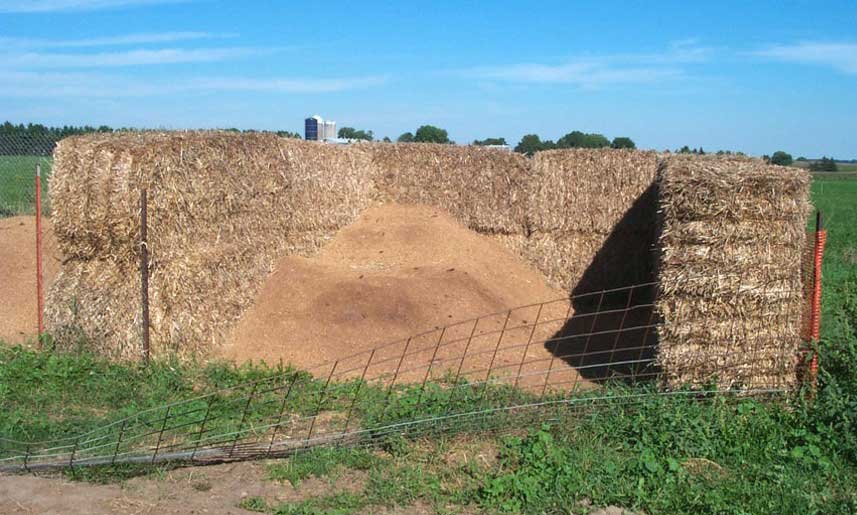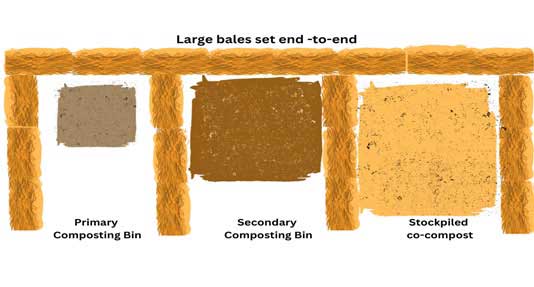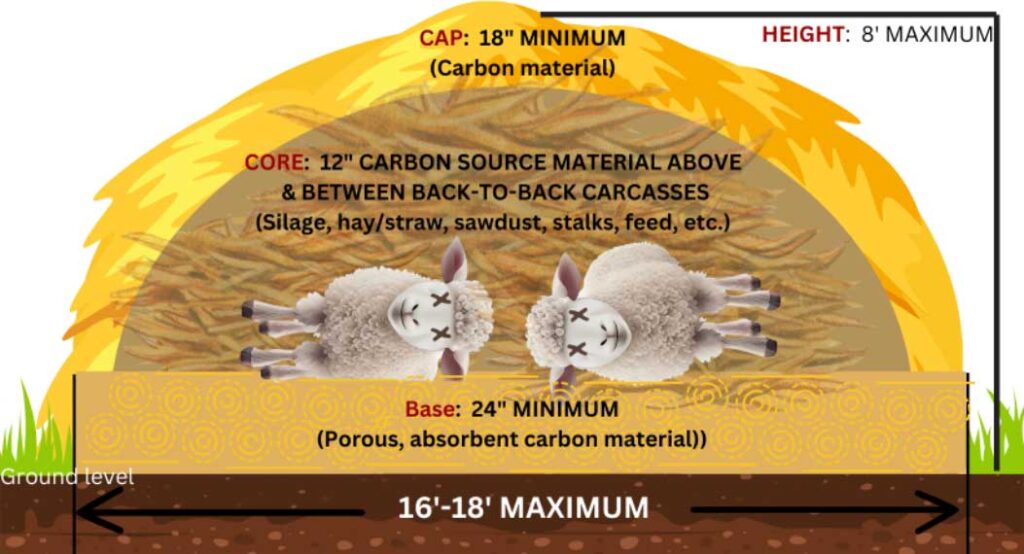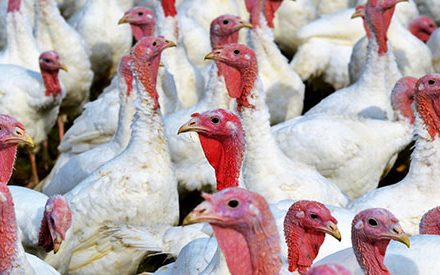Introduction
On-farm composting is an approved method to dispose of livestock mortalities. Advantages include increased biosecurity, timely disposal of mortalities, low risk of environmental contamination, low cost, and relatively simple to do. Composting can be used for occasional mortality, emergency livestock mass casualties, and disease outbreaks.

What is composting?
Composting is an aerobic (with oxygen) recycling process where microorganisms break down organic material in a controlled environment to produce a stable product called humus. There are many ways to compost livestock mortalities. However, there are a few basics that are universal to all systems. Well-managed composting provides aerobic (oxygen-loving) microorganisms with the proper environment to grow and rapidly break down the mortality.
Carbon-to-Nitrogen Ratio
One of the key factors in proper composting is the carbon-to-nitrogen ratio. The optimum carbon-to-nitrogen ratio should be 25:1, with composting occurring as low as 10:1 and as high as 50:1. If carbon levels are too low, high ammonia odors will escape. The primary nitrogen source is the mortality (typically about 5:1 C:N). The carbon is supplied by the bulking material/co-compost/carbon source material used to make the pile. Common materials used as a carbon source are sawdust, woodchips, finely chopped corn stalks, chopped straw, bedded pack manure, and separated manure solids. Corn silage and chopped hay could be used if other materials cannot be found. There are many considerations when choosing a carbon source, the first being availability. Beyond availability, another thing to consider is the amount of carbon that can be provided for absorbency to handle any liquids released from the carcass during the process, a structure that can allow for proper oxygen exchange, insulating factor, and particle size. Particle size should be in the range of .25-1 inch. Previously used composted material should be used as 50% or less of the carbon source.
Table 1. Carbon to Nitrogen (C:N) and percent moisture values of common carbon sources
| Materials | C:N | Moisture, % |
|---|---|---|
| Corn stalks | 60-73:1 | 12 |
| Corn silage | 38-43:1 | 65-68 |
| Hay | 15-43:1 | 8-10 |
| Cow manure solids | 11-30:1 | 67-87 |
| Horse manure solids | 22-50:1 | 59-79 |
| Straw | 48-150:1 | 4-27 |
| Sawdust | 200-750:1 | 19-65 |
| Woodchip | 451-891:1 | — |
| Leaves | 40-80:1 | — |
Moisture
The ideal moisture range for composting is 40-60%. A rule of thumb for proper moisture content would be to squeeze a handful of material; the material should hold together but not be so wet that water can be squeezed from the solids, like a damp sponge. If the compost is too dry, bacteria growth will be slowed and decomposition will take longer. If there is too much moisture, there will not be enough air exchange, and the bacterial type will change from aerobic to anaerobic. Anaerobic bacteria produce sulfur and ammonia-containing gasses that produce strong offensive odors.
Temperature
The final components of proper composting are temperature, oxygen, and pH. As stated before, proper oxygen levels are needed to keep aerobic bacteria growing. The minimum oxygen level needed is 5%. Bacteria and fungi needed for this process need a neutral environment at around a pH of 7, ranging from 5-10. Temperature is key in bacterial growth, and temperatures rise as decomposition occurs. Temperatures between 110 -150 °F indicate that microbes are present and optimum decomposition occurs. The pile must be heated to 131°F for three consecutive days to destroy pathogens. When the pile temperatures drop below 110°F, this can indicate it is time to turn the pile to add oxygen and stimulate bacterial growth. Temperatures at or above 150 °F will decrease microbial activity. The length of time needed to compost mortalities depends on the mortality size and time of year (ambient air temperatures). In most cases, the first heating cycle will be done in three to six months, and the pile is turned for a second heating and possibly a third. With ideal conditions, it typically takes about three months for most of the soft tissue to be degraded and may take up to a year to completely decompose. Temperature monitoring will indicate when to turn.
Winter months can present challenges with freezing temperatures. New compost piles, constructed with unfrozen materials and fresh mortalities, will start to compost provided enough insulation material is used to retain the heat produced within the pile. Unfrozen recent mortalities can also be added to an existing actively composting pile provided enough insulating material is used. Mortalities, which freeze up, when used with cold materials to construct a compost pile will struggle to start the composting process.
Caution should be used to immediately place the fresh mortalities into a compost pile to avoid the toll of freezing temperatures. The cap material shown in Figure 1 can serve the purpose of insulation and maintaining heat within the pile. The thickness of the cap materials may need to be increased during winter months to increase its insulation capacity.
When is the composting process complete?
When temperatures remain within a few degrees of ambient air temperature after turning, the process is complete. The mortality should be reduced to a few large brittle bones and in the case of sheep, some wool fibers, which can be buried, and the compost utilized as a soil amendment.
Pile Construction
The number and frequency of mortalities and available facilities and materials will determine the type of composting setup. The number and size of the animals to be composted will determine the size of the pile for occasional composting needs. In general piles should be at least 3 feet deep if composting small animals (poultry, baby lambs) and not more than 8 feet deep for large animals to insure good composting. It is more practical to make longer piles than deeper piles for multiple larger animals. Piles can be placed in permanent locations, such as a 3-sided building with concrete walls with multiple bins/stages, outside with bales as walls, a single static pile, or a windrow. However, loading all of these systems is very similar. Structures with walls will reduce the amount of carbon source material needed.
- The basics to loading are to put down a layer of carbon source material about 24 inches deep and in an area large enough to have 24 inches of space between the mortality and the edge of the pile.
- Next is to lay the mortality on its side. At this point, the abdomen may be lanced to reduce bloating in the composting process and to allow microbes access to nitrogen.
- Next, cover the mortality with another 24-inchlayer of carbon source material. (Figure 1)
- If multiple mortalities are added at once, laythem in the pile so they are lying back-to-back. (Figure 2)
- If they are layered, place a 12-inch layer of carbon source material in between the mortality layers.
- If the pile is outdoors, crown the pile to facilitate the runoff of rain.
- A fence can prevent scavengers from disrupting the pile when working with outside compost systems.
Windrow systems are a good option if there are frequent mortalities. In a windrow system, mortalities are added end to end as they occur to create a long “windrow” of compost with turning occurring in sections.
A multiple bin set-up, as shown in Figure 3., can help organize the composting process and provide protection from the wind. The example in Figure 3 shows low-cost dividers made of large round or square bales of corn stalks or similar material. Large livestock operations may consider constructing an appropriately sized building similar in floor plan to a commodity shed with a roof, permanent walls, and bin dividers to improve ease of management of composting mortalities. The plan’s design is intended for each phase to have its own bin. The initial burial and heating cycle would occur in the first bin. As the pile is turned, it is moved to the next bin. The first bin would then be available for starting new mortalities. Additional bins can be added to store bulking material before its use for composting and for completed compost if it cannot promptly be land applied.
The advantages of a multiple-bin layout are additional protection from the wind and a systematic plan for large operations with greater composting needs. Farms with occasional mortalities may also construct a bin or shelter around a single pile if additional protection from the wind is needed. Costs need to be compared to benefits to determine the most efficient setup and design for a farm.
Figure 3. Example of a low-cost multiple bin setup using large bales

Site Selection
The compost facility/pile site should be high and dry. Environmental considerations must be made. The site should be located away from frequently used farm traffic routes yet be easily accessed by needed equipment, be close to carbon source storage, and be easy to get water to if the carbon source material becomes too dry. Public perception and neighbor relations should also be considered.
- Avoid wet areas; the location must be high and dry.
- Avoid slopes and areas with surface water flowduring rain events and snowmelt.
- Locate at least 3 feet above a high water table.
- Locate at least 300 feet from streams, ponds, or lakes in the same drainage area.
- Provide runoff collection/storage for the site incase of extreme water events.
- Ensure available in access in all types of weather conditions.
- Maintain suitable access to carbon source material storage.
- Locate a safe distance from buried and overhead utilities.
- Consider other farm traffic flows.
- Consider prevailing winds.
- Maintain biosecurity precautions.
- Consider aesthetics and landscaping – Screen view from neighbors or passing motorists.
Additional Resources
Composting Dead Livestock: New solution to an old Problem. Iowa State University, 1999. https://datcp.wi.gov/Documents/iowacompostguide.pdf
Composting Animal Mortalities, D.E. Morse, et.al. July 2006, https://datcp.wi.gov/Documents/minnesotacompostguide.pdf
Natural Rendering: Composting Livestock Mortality and Butcher Waste, Cornell Waste Management Institute, Cornell Cooperative Extension, 2002 https://datcp.wi.gov/Documents/cornellcompostguide.pdf
Corus, E. (2020). Composting livestock and poultry carcasses. University of Minnesota Extension. Composting livestock and poultry carcasses | UMN Extension
Rozeboom, D. (2015). Carcass composting – A guide to mortality management on Michigan cattle farms. https://www.canr.msu.edu/resources/carcass_composting_a_guide_to_mortality_management_on_michigan_cattle_farms
Peer Reviewers
Kapil Arora, Ph.D.
Field Agricultural Engineer
Iowa State University
Stanley (Jay) Solomon
Extension Educator Natural Resources, Environment & Energy
University of Illinois
Authors

William Halfman
Beef Outreach Specialist – Bill’s educational programming has focused on beef cattle production and management, agronomic crops and soils production and management, small scale fresh market and bedding plant production, and specialty crop management.
Carolyn Ihde
Carolyn Ihde is a Small Ruminant Outreach Specialist for the University of Wisconsin-Madison, Division of Extension, Agriculture Institute.
Download Article





 Composting mortalities to improve biosecurity
Composting mortalities to improve biosecurity Biosecurity: Start with small steps
Biosecurity: Start with small steps Avian Influenza and Biosecurity – 2020
Avian Influenza and Biosecurity – 2020 Biosecurity in the feedlot
Biosecurity in the feedlot


